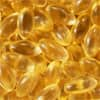
What's hot
What's hot
News flashes are posted here frequently to keep you up-to-date with the latest advances in health and longevity. We have an unparalleled track record of breaking stories about life extension advances.
Omega-3 deficiency could contribute to teens’ psychological disorders
 July 31, 2013. Findings reported in an article published online on July 29, 2013 in Biological Psychiatry suggest that modern omega-3 fatty acid deficient diets could be the culprit behind the prevalence of anxiety, hyperactivity, and poor cognition observed among many adolescents.
July 31, 2013. Findings reported in an article published online on July 29, 2013 in Biological Psychiatry suggest that modern omega-3 fatty acid deficient diets could be the culprit behind the prevalence of anxiety, hyperactivity, and poor cognition observed among many adolescents.
By breeding successive generations of rats that were given diets containing reduced amounts of omega-3 fatty acids, Bita Moghaddam and colleagues at the University of Pittsburgh created a model of the deficiency that has occurred in humans over the past several decades when animals used for meat were switched from an omega-3 rich grass-based diet to one based on grains. The researchers found an increase in anxiety and hyperactivity in adolescent animals, as well as a reduction in the rate of learning and problem-solving, in comparison to animals given diets that contained adequate amounts of omega-3. “We have always assumed that stress at this age is the main environmental insult that contributes to developing these conditions in at-risk individuals but this study indicates that nutrition is a big factor, too,” stated Dr Moghaddam. “We found that this dietary deficiency can compromise the behavioral health of adolescents, not only because their diet is deficient but because their parents’ diet was deficient as well. This is of particular concern because adolescence is a very vulnerable time for developing psychiatric disorders including schizophrenia and addiction.”
“Our study shows that, while the omega-3 deficiency influences the behavior of both adults and adolescents, the nature of this influence is different between the age groups,” Dr Moghaddam noted. “We observed changes in areas of the brain responsible for decision making and habit formation.”
“It’s remarkable that a relatively common dietary change can have generational effects,” Dr Moghaddam added. “It indicates that our diet does not merely affect us in the short-term but also can affect our offspring.”
—D Dye
High intake of red meat linked with risk of type 2 diabetes
 July 29, 2013. A review published in the July issue of Advances in Nutrition found an association between a high intake of red meat intake and an increased risk for type 2 diabetes.
July 29, 2013. A review published in the July issue of Advances in Nutrition found an association between a high intake of red meat intake and an increased risk for type 2 diabetes.
Advanced glycation end products (AGEs) and advanced lipoxidation end products (ALEs) were proposed as mechanisms, with iron as the potential link. Iron facilitates the formation of AGEs and ALEs during the processing and cooking of red meat.
The review included previous findings linking AGEs to insulin resistance and impaired insulin secretion. In an animal model, AGEs inhibited insulin-producing β cells.
The scientists conducting the review concluded, “Meta-analyses of body iron status as measured by serum ferritin demonstrate a positive relationship with the risk of type 2 diabetes … The level of contribution from iron to dietary protein oxidation and AGE development in processing is not known, but experimental laboratory testing of this should be carried out in meats with varying lipid contents and between red meat and other dietary AGEs.”
—D Dye
Lower Risk of Mortality for Coffee and Tea Drinkers
 July 26, 2013. In the August issue of the Journal of Nutrition, an article was published showing a lower risk of mortality for coffee and tea drinkers.
July 26, 2013. In the August issue of the Journal of Nutrition, an article was published showing a lower risk of mortality for coffee and tea drinkers.
The study included 2461 participants (over 40 years of age) and formed part of the Northern Manhattan Study. At baseline, participants were free of stroke, cancer, and myocardial infarction.
Researchers examined the association by food frequency questionnaire during an 11 year follow-up. The majority of participants were coffee and tea drinkers.
A 7% reduction in mortality was seen for each additional cup of coffee and tea ingested per day. Strong protection was seen in those who drank 4 or more cups of regular caffeinated coffee. Additionally, a 9% decreased risk of mortality was seen for each increased cup of tea per day.
The proposed culprit is the high antioxidant content of these beverages, although the researchers concluded that further study is needed.
—D Dye
Avoidance of estrogen replacement by hysterectomized women estimated to result in lost lives
 July 24, 2013. In an article published on July 18, 2013 in the American Journal of Public Health Yale researchers calculate that nearly 50,000 unnecessary deaths have occurred among women between the ages of 50 and 69 years who had a hysterectomy yet had not availed themselves of estrogen replacement therapy due to fear of its adverse risks.
July 24, 2013. In an article published on July 18, 2013 in the American Journal of Public Health Yale researchers calculate that nearly 50,000 unnecessary deaths have occurred among women between the ages of 50 and 69 years who had a hysterectomy yet had not availed themselves of estrogen replacement therapy due to fear of its adverse risks.
Findings from the Women’s Health Initiative (WHI) study published in 2002 indicated a greater risk of breast cancer and coronary heart disease among women who used a combination of estrogen and progestin as menopausal hormone replacement therapy. Progestin is routinely combined with estrogen to protect against increased proliferation of the uterine lining that can result from the administration of unopposed estrogen. However, in the WHI study arm that investigated the use of estrogen alone (which is prescribed without progestin to women who have had hysterectomies) there was a decrease in the risk of breast cancer and heart disease, and a lower rate of mortality in comparison with women who received a placebo. Nevertheless, the backlash from the widely publicized findings of the first arm of the study frightened many women away from any kind of hormone replacement therapy, including estrogen alone or bioidentical hormones that have been associated with fewer risks. "Sadly, the media, women, and health care providers did not appreciate the difference between the two kinds of hormone therapy," commented lead researcher Philip Sarrel, MD. "As a result, the use of all forms of FDA-approved menopausal hormone therapy declined precipitously."
"Estrogen avoidance has resulted in a real cost in women's lives every year for the last 10 years—and the deaths continue," he added. "We hope this article will stir an overdue debate and raise consciousness about the health benefits of estrogen-only therapy for women in their 50s with no uterus."
—D Dye
CoQ10 supplementation improves glycemic control, lowers cholesterol in randomized trial
 July 22, 2013. The June, 2013 issue of the journal Minerva Gastroenterologica e Dietologica describes a clinical trial conducted at Tehran University of Medical Sciences in Iran which found improved glycemic control and lower cholesterol levels among diabetics given coenzyme Q10 (CoQ10).
July 22, 2013. The June, 2013 issue of the journal Minerva Gastroenterologica e Dietologica describes a clinical trial conducted at Tehran University of Medical Sciences in Iran which found improved glycemic control and lower cholesterol levels among diabetics given coenzyme Q10 (CoQ10).
The trial included 64 men and women between 20 and 60 years of age with type 2 diabetes who were randomized to receive 200 milligrams coenzyme Q10 or a placebo for 12 weeks. Blood samples collected upon enrollment and at the trial’s conclusion were analyzed for fasting glucose, hemoglobin A1C (a measure of long term glucose control) and lipids.
At the end of the trial, serum hemoglobin A1C, total cholesterol, and low density lipoprotein (LDL) cholesterol were reduced in the group that received CoQ10 but did not change significantly in the placebo group. Fasting glucose, triglycerides and high density lipoprotein (HDL) cholesterol did not appear to be affected by CoQ10.
In their discussion, authors R. Kolahdouz Mohammadi and colleagues comment that the elevation of blood glucose that occurs in diabetes can increase the generation of reactive oxygen species, which worsen diabetes complications and pancreatic beta cell dysfunction. The decreased antioxidant reserve observed in diabetics may be responsible for some of the benefits attributed to CoQ10 supplementation which, due to its antioxidant property, helps protect beta cells from glucose toxicity.
“The results of this study showed that 12 weeks Q10 supplementation can improve glycemic control, total cholesterol and LDL cholesterol but further studies are needed to confirm these findings,” they conclude.
—D Dye
North Americans deficient in omega-3 fatty acids
 July 19, 2013. A presentation at the 2013 Institute of Food Technologists Annual Meeting & Expo, held in Chicago July 13-16, 2013, revealed a profound lack of omega-3 polyunsaturated fatty acids in the standard North American diet, despite what is known of the fatty acids’ benefits. Physicians and their patients are being made increasingly aware of the role of omega-3 fatty acids in the prevention or reduction of inflammatory disorders and cardiovascular disease, among other conditions. However, the eating habits of most Americans still have a lot catching up to do.
July 19, 2013. A presentation at the 2013 Institute of Food Technologists Annual Meeting & Expo, held in Chicago July 13-16, 2013, revealed a profound lack of omega-3 polyunsaturated fatty acids in the standard North American diet, despite what is known of the fatty acids’ benefits. Physicians and their patients are being made increasingly aware of the role of omega-3 fatty acids in the prevention or reduction of inflammatory disorders and cardiovascular disease, among other conditions. However, the eating habits of most Americans still have a lot catching up to do.
Nutritional researcher Bruce J. Holub, PhD, who is a professor emeritus at the University of Guelph in Ontario, along with Alex Richardson, PhD, of the Centre for Evidence-Based Intervention at the University of Oxford in England attribute the widespread omega-3 deficiency to diets that provide little in the way of fish or seafood, which are the best food sources of the omega-3 fatty acids eicosapentaenoic acid (EPA) and docosahexaenoic acid (DHA). The average North American diet provides 200 milligrams EPA and/or DHA per day, which falls short of the American Heart Association’s recommendation of 500 milligrams per day for healthy adults and 900 milligrams per day (which can be provided by one omega-3 supplement) for those with cardiovascular disease. For children, Dr Richardson suggests 500 milligrams omega-3 fatty acids per day, and for pregnant women, he recommends one gram.
“Physical risks to children from a nutritionally poor diet are now acknowledged, but the damage being done to their behavior, their learning abilities and mood is not,” he stated. “I applaud any attempts (to recommend and encourage supplements) in the diets of mothers and women of childbearing age. It’s never too late.”
—D Dye
Vitamin D deficiency makes life harder for older adults
 July 17, 2013. The results of a study published on July 17, 2013 in the Journal of Clinical Endocrinology & Metabolism reveal a greater risk of difficulty with performing everyday tasks among older men and women who are deficient in vitamin D.
July 17, 2013. The results of a study published on July 17, 2013 in the Journal of Clinical Endocrinology & Metabolism reveal a greater risk of difficulty with performing everyday tasks among older men and women who are deficient in vitamin D.
The study included 597 men and women aged 55 to 65 and 762 subjects aged 65 to 88 enrolled in The Longitudinal Aging Study Amsterdam. Questionnaires administered upon enrollment and at three and six years of follow-up provided information on the participants’ ability to perform such activities as climbing or descending stairs, dressing and undressing, sitting down and standing up from a chair, and other tasks.
Among the older group, a serum 25-hydroxyvitamin D level of less than 20 nanograms per milliliter (ng/mL) was associated with a 70% greater risk of having one or more functional limitations in comparison with a level of 30 ng/mL or higher, and for those in the younger group, the risk associated with low vitamin D was twice as high. Older subjects who had the lowest vitamin D levels had double the risk of developing additional limitations at three years of follow-up compared to those in the highest group, and for the younger group, the risk tripled after six years.
"Seniors who have low levels of vitamin D are more likely to have mobility limitations and to see their physical functioning decline over time," commented lead author Evelien Sohl, MSc, of VU University Medical Center. "Older individuals with these limitations are more likely to be admitted to nursing homes and face a higher risk of mortality."
"The findings indicate low vitamin D levels in older individuals may contribute to the declining ability to perform daily activities and live independently," Sohl added. "Vitamin D supplementation could provide a way to prevent physical decline, but the idea needs to be explored further with additional studies."
—D Dye
Meta-analysis indicates preventive effect for vitamin D against risk of respiratory tract infection
 July 15, 2013. The June, 2013 issue of the journal PLOSONE (Public Library of Science One) published the results of a meta-analysis conducted by researchers at Sweden’s Karolinska Institutet which found a protective role for supplementing with D to reduce the risk of respiratory tract infection.
July 15, 2013. The June, 2013 issue of the journal PLOSONE (Public Library of Science One) published the results of a meta-analysis conducted by researchers at Sweden’s Karolinska Institutet which found a protective role for supplementing with D to reduce the risk of respiratory tract infection.
For their analysis, Jonatan D. Lindh of the Karolinska Institutet’s Division of Clinical Pharmacy and his associates selected 11 randomized, placebo-controlled trials that included a total of 5,660 participants averaging 16 years of age. The average dose of vitamin D was 1,600 international units (IU) administered orally. Follow-up periods ranged for three months to three years.
Supplementation with vitamin D resulted in a 36% lower risk of respiratory tract infection compared to placebo in a summary of all 11 trials. When studies using daily dosing regimens were examined, vitamin D supplementation resulted in a 49% lower risk of infection in comparison with the placebo, while large bolus doses administered monthly or less frequently were not as effective. The researchers attribute this phenomenon to an immunosuppressive effect associated with very high doses of vitamin D, which renders high bolus doses of the vitamin useful for the treatment of inflammatory disorders, including multiple sclerosis. “This could explain why many of the studies using bolus doses have provided null effect and is also important information when designing future interventional studies,” the authors remark.
“Aggregated evidence from 11 randomized controlled trials indicates that supplementation with vitamin D could be an effective means of preventing respiratory tract infection,” they conclude. “However, due to heterogeneity of included studies and possible publication bias in the field, these results should be interpreted with caution. Thus, additional studies addressing the impact of dosing regimen and choice of target population are warranted before definite conclusions can be drawn.”
—D Dye
Choline improves memory and attention in rodents
 July 12, 2013. In a collaboration between scientists at the University of Granada in Spain, Venezuela’s Simón Bolívar University and the University of York in England, a benefit for the B vitamin choline on attention and memory has been demonstrated in research involving rats.
July 12, 2013. In a collaboration between scientists at the University of Granada in Spain, Venezuela’s Simón Bolívar University and the University of York in England, a benefit for the B vitamin choline on attention and memory has been demonstrated in research involving rats.
In an initial experiment, Hayarelis Moreno-Gudiño and her colleagues gave pregnant rats a standard diet, a diet enriched with choline or a choline-deficient diet. Ten of the animals’ offspring were selected from each group upon reaching adulthood and tested for memory retention.
While all of the animals were able to remember an object 24 hours after it was shown to them, those born to mothers who received extra choline during pregnancy were better able to recognize the object after 48 hours than animals born to mothers given a standard diet. Rats born to mothers provided with diets deficient in choline were unable to remember the object after two days, indicating a deleterious effect for prenatal choline deficiency on long term memory.
In another experiment, rats were given a diet supplemented with choline or an unsupplemented standard diet for 12 weeks prior to undergoing tests of attention. Rats that received the choline-enriched diet maintained better attention than the control group when presented a familiar stimulus and demonstrated an improvement in learning. The research was reported in the April 15, 2013 issue of the journal Behavioural Brain Research.
“These results are consistent with a role for the cholinergic system of the basal forebrain in modulation of attention,” the authors conclude. The findings suggest that supplemental choline could play an important role in prenatal nutrition, however, further studies are needed to confirm the vitamin’s benefit.
—D Dye
Increased urinary polyphenols linked with longer life
 July 10, 2013. An article published on June 26, 2013 in the Journal of Nutrition reports the finding of Spanish and Italian researchers of an association between higher urinary concentrations of polyphenols measured in older adults and a reduced risk of dying over a twelve year period. Polyphenols are compounds that occur in plants that have been found to have antioxidant, anti-inflammatory, antiobesity and other effects.
July 10, 2013. An article published on June 26, 2013 in the Journal of Nutrition reports the finding of Spanish and Italian researchers of an association between higher urinary concentrations of polyphenols measured in older adults and a reduced risk of dying over a twelve year period. Polyphenols are compounds that occur in plants that have been found to have antioxidant, anti-inflammatory, antiobesity and other effects.
The study included 807 men and women enrolled in the Invecchiare in Chianti study of older adults. Dietary questionnaires administered upon enrollment provided information on polyphenol intake and total urinary polyphenols were measured in urine samples.
Over twelve years of follow-up, 66 participants died of cardiovascular disease, 112 died of cancer and 72 deaths were due to other causes. Among participants whose total urinary polyphenols were among the top one-third of participants, the adjusted risk of dying over follow-up was 30% lower than those whose levels were among the lowest third. While no significant association with mortality was found for dietary intake of polyphenols, the authors remark that validated biomarkers such as urinary polyphenols have an advantage over self-reported intake due to their independence from the biases and errors associated with self-reporting, and they note that food composition tables used to estimate intake were incomplete, resulting in underestimation.
“This study is, to the best of our knowledge, the first population-based prospective study to assess the association between total urinary polyphenol concentrations and mortality in older participants,” authors Raul Zamora-Ros and colleagues announce. “Moreover, we used total urinary polyphenol concentrations as a biomarker of total dietary polyphenols, which is a more reliable and accurate measure of intake.”
“Total urinary polyphenols is an independent risk factor for mortality among community-dwelling older adults, suggesting that high dietary intake of polyphenols may be associated with longevity,” they conclude.
—D Dye
More evidence for protective role of vitamin D against development of uterine fibroids
 July 8, 2013. Close on the heels of a U.S. study published in May of this year which found an association between reduced vitamin D levels and a greater risk of uterine fibroids, a study of Italian women published online on July 3, 2013 in The Journal of Clinical Endocrinology & Metabolism has uncovered a similar finding.
July 8, 2013. Close on the heels of a U.S. study published in May of this year which found an association between reduced vitamin D levels and a greater risk of uterine fibroids, a study of Italian women published online on July 3, 2013 in The Journal of Clinical Endocrinology & Metabolism has uncovered a similar finding.
Uterine fibroids or leiomyomas are benign tumors that develop in or around the uterus which occur in a significant number of women. Although the majority of cases do not require treatment, the condition can result in pain, bleeding, urinary frequency and other complications that can necessitate removal of the fibroids or, in some cases, the entire uterus.
“Recent in vitro and in vivo experimental evidence supports a role of vitamin D insufficiency as an important factor in the development of uterine leiomyomas,” note Alessio Paffoni of Ospedale Maggiore Policlinico and his colleagues. “However, epidemiological data supporting this possibility are scanty.”
The current study age-matched each member of a group of 128 women who had at least one fibroid detected by ultrasound examination with two control subjects who did not have the condition. Among women with fibroids, serum 25-hydroxyvitamin D3 levels averaged 10 nanograms per milliliter (ng/mL), in comparison with 20.8 ng/mL in the control group. Vitamin D deficiency, defined as serum levels lower than 10 ng/mL, occurred in 15% of women with fibroids and in 7% of the controls, resulting in a 2.4 times greater risk of fibroids experienced by deficient women.
“Vitamin D is an emerging regulator of uterine leiomyoma development,” the authors conclude. “Cohort and interventional studies are pressingly needed to confirm a causal relationship and to investigate the potential therapeutic benefits of vitamin D supplementation.”
—D Dye
Greater fruit and vegetable intake associated with increased survival over 13 year period
 July 5, 2013. An article published online on June 26, 2013 in the American Journal of Clinical Nutrition reveals an association between increased vegetable and fruit intake and a lower risk of dying during 13 years of follow-up.
July 5, 2013. An article published online on June 26, 2013 in the American Journal of Clinical Nutrition reveals an association between increased vegetable and fruit intake and a lower risk of dying during 13 years of follow-up.
The analysis included 38,221 participants in the Cohort of Swedish Men who were recruited between 1997 and 1998, and 33,485 women recruited from 1987 to 1990 to participate in the Swedish Mammography Cohort. Questionnaires completed upon enrollment provided data concerning diet over the previous year, alcohol intake, and other lifestyle factors.
From the beginning of 1998 through 2010, 6,803 men and 4,637 women died. In comparison with subjects who consumed the recommended five servings of fruit and vegetables per day, those who did not consume fruit or vegetables had a 53 percent greater risk of dying over follow-up. As fruit and vegetable intake increased, the risk of mortality in comparison with consuming five per day declined. No additional benefit was observed for an intake greater than five fruits or vegetables daily.
When fruit and vegetable intake were analyzed separately, those who consumed no fruit lived on average 19 months less than subjects who consumed one fruit per day, and those who reported eating three or more servings vegetables per day survived an average of 32 months longer than those who didn’t consume them.
“Research has mainly focused on the association between fruit and vegetable consumption and specific major chronic diseases such as cardiovascular disease and different cancers,” write Andrea Bellavia and colleagues at the Karolinska Institutet. “However, the study of the association of daily fruit and vegetable consumption with overall mortality represents a primary and basic tool to explore its effects on health as a whole and needs to be kept in consideration while providing dietary recommendations.”
—D Dye
How DHA controls inflammation
 July 3, 2013. The July, 2013 issue of The FASEB Journal published the discovery of researchers at Boston's Brigham & Women's Hospital and Harvard Medical School of a mechanism for docosahexaenoic acid (DHA, an omega-3 fatty acid that occurs in fish oil and algae) in reducing inflammation. Omega-3 fatty acids have been known to have an anti-inflammatory effect, yet how this occurs has not been well defined.
July 3, 2013. The July, 2013 issue of The FASEB Journal published the discovery of researchers at Boston's Brigham & Women's Hospital and Harvard Medical School of a mechanism for docosahexaenoic acid (DHA, an omega-3 fatty acid that occurs in fish oil and algae) in reducing inflammation. Omega-3 fatty acids have been known to have an anti-inflammatory effect, yet how this occurs has not been well defined.
Charles N. Serhan, PhD and his colleagues found that human immune cells known as macrophages convert DHA to an intermediate compound labeled 13S, 14S-epoxy-maresin. "Maresins are produced by macrophages from docosahexaenoic acid (DHA) and exert potent proresolving and tissue homeostatic actions," Dr Serhan and his coauthors write. "Maresin 1 is the first identified maresin."
As the result of synthesizing the intermediate molecule, they found that it promoted the conversion of macrophages from the M1 phenotype to the M2 phenotype that does not stimulate inflammation. "We hope that the results from this study will enable investigators to test the relevance of the maresin pathway in human disease," Dr Serhan stated. "Moreover, we hope to better understand resolution biology and its potential pharmacology so that we can enhance our ability to control unwanted inflammation and improve the quality of life."
"We've known for a long time that DHA tames inflammation, now, we learn exactly how DHA works: via new substances called maresins," commented Gerald Weissmann, MD, who is The FASEB Journal'sEditor-in-Chief of. "We encounter inflammation almost daily, but our body has ways of turning it off. This is an important step toward understanding exactly this happens. You're likely to be hearing a lot more about maresins if, or when, new therapies arise from this discovery."
—D Dye
Meta-analysis associates green tea with improved glucose control
 July 1, 2013. The results of a meta-analysis described in an article published online on June 26, 2013 in the American Journal of Clinical Nutrition reaffirm the benefit of drinking green tea in maintaining glucose control among individuals at risk of metabolic syndrome.
July 1, 2013. The results of a meta-analysis described in an article published online on June 26, 2013 in the American Journal of Clinical Nutrition reaffirm the benefit of drinking green tea in maintaining glucose control among individuals at risk of metabolic syndrome.
A team from Chongqing Medical Nutrition Research Center in China selected 17 trials that included a total of 1,133 participants for their analysis. Trials were limited to those in which subjects consumed green tea or an extract of green tea for at least two weeks and had fasting glucose or insulin measured before and after treatment, in addition to other criteria. Green tea catechin content ranged from 208 to 1,207 milligrams per day. Of the trials selected, nine involved participants who were overweight or obese, four included type 2 diabetics, two involved subjects with borderline diabetes and two were limited to healthy participants.
Green tea intake was shown to be significantly associated with reductions in fasting glucose and hemoglobin A1c, a marker of long-term glucose control. Subgroup analyses determined that fasting glucose was reduced in participants at risk of metabolic syndrome but not in healthy subjects, and that green tea consumption was beneficial only when providing a level of catechins of at least 457 milligrams per day. Additional analysis of data extracted from high-quality trials indicated that green tea consumption significantly reduced fasting insulin.
"Green tea significantly lowered fasting glucose and hemoglobin A1c concentrations, and the results of our stratified analyses suggested that green tea may also reduce fasting insulin concentrations," Kai Liu and colleagues conclude. "Additional long-term and high-quality randomized controlled trials specifically designed to evaluate the effects of green tea on glucose control and insulin sensitivity are needed to further evaluate and confirm these findings."
—D Dye
